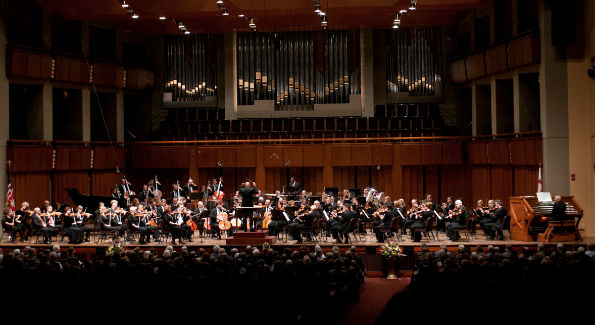The new Kennedy Center organ was debuted, to mixed reviews, in a free concert with NSO.

The National Symphony Orchestra performed during the Kennedy Center Debut Concert. (Photo by Margot Ingoldsby Schulman)
After many years of lamenting over the woes of the Kennedy Center’s Filene Organ, the debut of a new instrument was a long-awaited occasion that called for a concert with the National Symphony Orchestra. The Rubenstein Family Organ was a gift from Kennedy Center Chairman David Rubenstein. In his opening remarks, center President Michael Kaiser lavished high praise upon Rubenstein for the generosity of his gift and contributions to the arts nationally. In appreciation of the previous instrument, special attention was given to the Filene Stop, comprised of 61 pipes retained from the old organ as a way of commemorating the contributions of the Filene family to the center’s performances over the years. An engaging multi-media presentation projected on the screen in front of the organ, provided a few seemingly staged vignettes of the organ’s arrival and installation. Many of the city’s noted organists were in attendance, including American Guild of Organists President Eileen Guenther as well as Marvin Mills, J. Reilly Lewis, Samuel Carabetta, Benjamin Hutto and Michael Lodico.
There has been speculation about the organ’s adequacy for the hall for months, which has been well documented in the D. C. Performing Arts Examiner on Examiner.com and by Anne Midgette in The Washington Post. It was rumored that the organ was originally meant for a local church that could no longer follow through on the financial commitment to secure the instrument. The new instrument by Casavant consists of 4, 972 pipes. In the district, there are churches that house pipe organs of equal or larger size, such as the organs at National City Christian Church, National Presbyterian Church, Washington National Cathedral and Saint Patrick’s Catholic Church (Chinatown location) to name a few. Many organists in the city voiced concern that the instrument was too small for the concert hall. The notion is one that certainly should have been entertained.
William Neil, principal organist for NSO began the program with the “Toccata and Fugue in D Minor” by Bach. Often used in feature films, especially at horrific moments, the work was a familiar one for the audience. From its opening notes, the organ simply did not have a resonance or body to the sound that would grab one’s attention. It was a full sound, but not quite one that reached towards the middle of the hall. Neil played with great technical facility, executing every note of work with accuracy.
In the contrasting fugue, the softer stops of the organ were used to great effect. Toward the end of the movement, the reeds of the organ gave a richer, darker color to the registration. The rapturous applause at the end from the audience seemed to be more about familiarity than being impressed by the actual sound of the instrument.
The evening did more to compliment the instrument as an ensemble or accompanying organ, rather than a solo one. Trombonist Craig Mulcahy joined Neill for the “Morceau Symphonique” by Guilmant. This work showcased the warmth of the organ’s strings and ability to partner with other sonorities. Mulcahy manuevered the musical passages with ease, playing with beautiful tone. The pomp of the trombone, balanced with the rich support of the organ, was a wonderful display of how the instrument can be used in a variety of musical functions. Gabrieli’s “Canzona a 12” featured two brass choirs of National Symphony players. The antiphonal effect of the instruments supported by organ accompaniment transported the listener to Saint Mark’s Venice, which was famed for presenting music in various galleries of the cathedral.
From first glance, the title of Camille Saint-Saëns‘ Organ Symphony would lend one to assume that the organ would have a prominent role throughout. Assistant Conductor Ankush Kumar Bahl drew a lush sound from the orchestra, particularly the strings. Of the entire work, the only moment of musical prominence for the organ came in the form of a solid, sustained C chord that would be repeated occasionally.
There was hardly a moment that really showcased a real bravura moment for organ. Rather, the combined forces of the orchestra with the organ brought the work to a towering climax.
Was one night truly enough to assess the full scope of the new instrument’s capabilities? Maybe not, but it was certainly an early indication.
Petersburg, Va. native Patrick D. McCoy received a B.M. in vocal performance from Virginia State University and an M.M. in church music from the Shenandoah Conservatory in Winchester, Va. He has contributed arts and culture pieces to CBS Washington, The Afro-American Newspaper and the newly published book, “In Spite of the Drawbacks” (Association of Black Women Historians), which includes his chapter on legendary soprano Leontyne Price. McCoy has interviewed some of the most acclaimed artists of our time, including Renée Fleming, Denyce Graves, Norman Scribner, Julian Wachner, Christine Brewer and Lawrence Brownlee. Listen to these interviews and others at Blog Talk Radio. McCoy may be reached via email at wlperformingarts@aol.com and on Twitter @PatrickDMcCoy.




